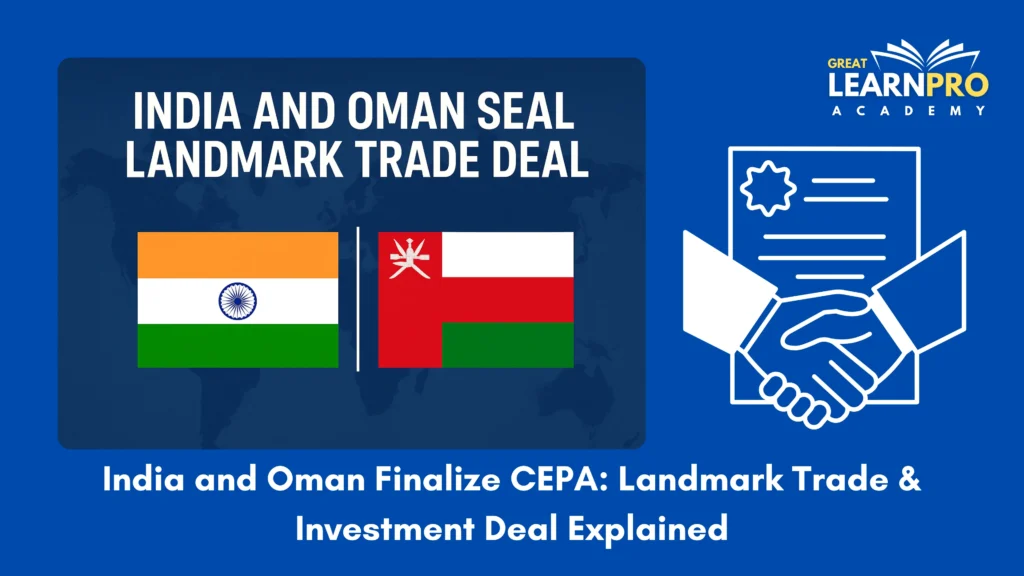
In a significant leap forward for bilateral trade and investment, India and Oman have concluded negotiations on a Comprehensive Economic Partnership Agreement (CEPA), marking a milestone in their economic relationship. Official sources indicate the agreement negotiations began in November 2023, and by March 2024, the two nations had ironed out all issues awaiting formal signing. Both sides agreed that the signing would take place after the formation of India’s new central government, signaling their intention to solidify this transformative pact promptly.
CEPA: A Game-Changer for Trade
Once ratified, the CEPA is set to eliminate or significantly reduce tariffs across a wide spectrum of goods including petroleum products, textiles, electronics, pharmaceuticals, machinery, iron, and steel thus unlocking vast opportunities for exporters on both sides.
India, one of Oman’s major trading partners within the Gulf Cooperation Council (GCC), will benefit from enhanced market access. In fiscal year 2022–23, bilateral trade exceeded $12 billion, though it moderated to about $8 billion in 2023–24.
In the most recent estimates, India’s exports to Oman totaled approximately $4.06 billion, while imports stood at around $6.55 billion in 2024–25, with petroleum products and urea making up over 70% of imports.
The Updated DTAA: Sharpening the Economic Edge
Parallel to CEPA, India and Oman also signed a protocol amending their Double Taxation Avoidance Agreement (DTAA) to align it with global norms and support evolving economic realities.
Effective from May 28, 2025, the revised DTAA introduces several critical changes:
- Expanded definition of “permanent establishment”, now encompassing digital and service-based operations reflecting the digital economy’s importance.
- Lower withholding tax rates on cross-border transactions to stimulate trade and investment.
- It offers significant relief to salaried professionals, freelancers, entrepreneurs, and companies with cross-border income streams by mitigating double taxation concerns.
This refined tax framework is expected to streamline financial operations for individuals and entities engaged across India and Oman, reducing compliance burdens while fostering deeper economic integration.
Broader Economic Impact and Strategic Significance
- Trade Expansion Across Key Sectors
The CEPA is not just about tariff reductions it paves the way for Indian manufacturers in textiles, electronics, pharmaceuticals, machinery, and steel to gain easier access to Omani and GCC markets. Simultaneously, Oman stands to benefit from strengthened ties in energy, infrastructure, and logistics. - Deepening Investment Flows
Indian investments in Oman reached over RO 750 million (~US$1.9 billion) by December 2023, while Omani investments to India totaled approximately RO 600 million (~US$1.5 billion) between 2000 and 2024.
The economic pact and updated tax treaty are expected to spur more investment, particularly in green energy, technology, healthcare, tourism, and infrastructure. - Technological and Green Energy Cooperation
During economic discussions held at the 11th India–Oman Joint Commission in Muscat, both sides explored collaboration in renewable energy (green hydrogen, green ammonia), food security, digital technology, healthcare, tourism, and special economic zones. They also proposed establishing a joint investment fund for infrastructure projects. - Strategic Benefits and GCC Linkages
Oman’s strategic location serves as a gateway to GCC markets. Reinforcing economic ties with Oman supports India’s broader ambitions to deepen engagement across the Gulf.
Furthermore, CEPA could enable India’s emergence as a green manufacturing hub, with companies potentially setting up units in Oman to utilize energy advantages and export to Europe and beyond.
- Boost for Services and Labor Mobility
The agreement also covers services and labor mobility paving the way for Indian firms and professionals to tap into Oman’s growth sectors, while making it easier for Omani firms to invest and operate in India.
Conclusion: A Transformative Economic Alliance
The combined impact of CEPA’s favourable trade terms and the modernized DTAA marks a watershed in India–Oman economic ties. Together, they chart a path toward robust trade growth, heightened investment flows, and strategic cooperation in future-facing sectors like clean energy, technology, and tourism.
As both economies stand at the threshold of this agreement’s formal signing, stakeholders across industries are optimistic about the long-term economic dividends. Whether it’s enhancing India’s export footprint or bolstering Omani participation in South Asia’s dynamic markets, the deal heralds a promising era in subcontinental–Gulf economic partnerships.
Sources:
- https://www.mea.gov.in/Portal/ForeignRelation/Oman-Dec-23.pdf
- https://www.google.com/amp/s/m.economictimes.com/news/economy/foreign-trade/india-concludes-trade-deal-negotiations-with-oman-date-on-economic-partnership-agreement-stands-unrevealed/amp_articleshow/123214569.cms
More Current Affairs: https://learnproacademy.in/updates/
